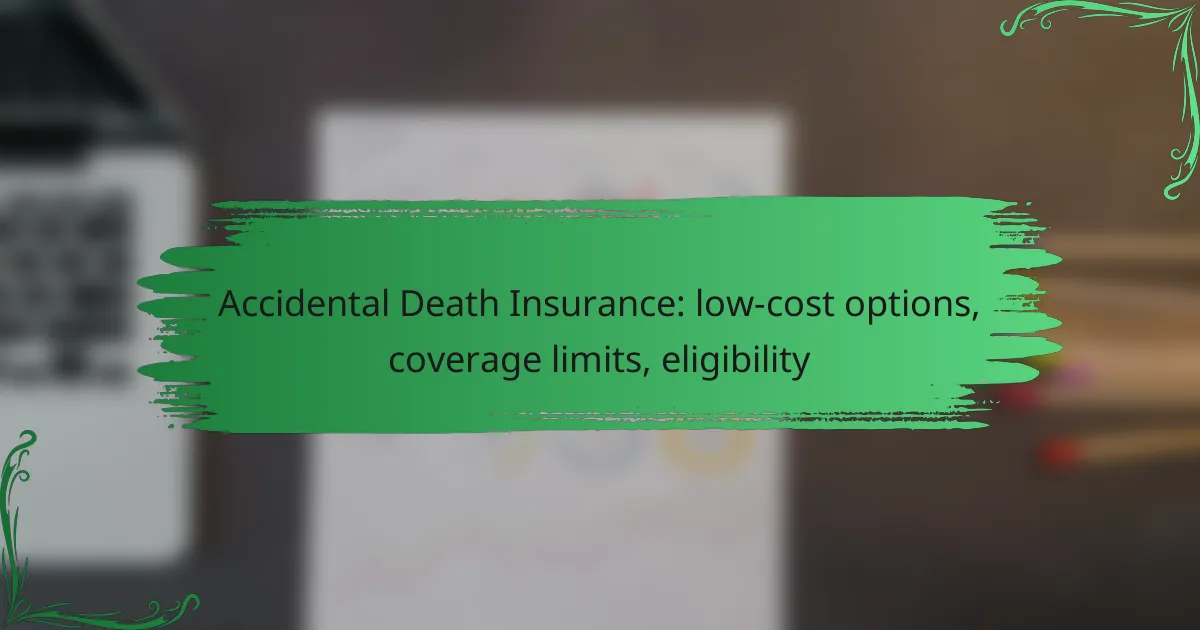Accidental death insurance offers low-cost options that can provide financial security for beneficiaries in the event of an unexpected tragedy. Coverage limits can vary significantly, typically ranging from tens of thousands to several million dollars, depending on individual needs and insurer criteria. Eligibility is generally based on factors such as age, health status, and occupation, ensuring that policies are tailored to suitable applicants.

What are the low-cost options for accidental death insurance in the UK?
Low-cost options for accidental death insurance in the UK include term life insurance policies, group accidental death insurance, and the use of online comparison tools. These options provide affordable coverage and can help ensure financial security for beneficiaries in the event of an accidental death.
Term life insurance policies
Term life insurance policies often offer affordable premiums and can include accidental death coverage as part of the plan. Typically, these policies provide a payout if the insured dies within a specified term, usually ranging from 10 to 30 years.
When considering term life insurance, look for policies that explicitly include accidental death benefits. Premiums can vary widely based on age, health, and coverage amount, but many start in the low tens of pounds per month.
Group accidental death insurance
Group accidental death insurance is often offered through employers or organizations and can be a cost-effective option for individuals. This type of coverage usually provides a fixed benefit amount for accidental death and may not require a medical exam.
Since group policies are typically subsidized by the employer, premiums are often lower than individual plans. However, coverage limits may be lower, and benefits may only apply while employed, so it’s essential to review the terms carefully.
Online comparison tools
Online comparison tools allow consumers to easily compare different accidental death insurance options and find low-cost policies that meet their needs. These tools can help identify the best coverage based on price, benefits, and insurer ratings.
When using comparison tools, input specific details such as age, health status, and desired coverage amount to receive tailored quotes. This can save time and help avoid common pitfalls like underinsurance or overpaying for coverage.

What are the coverage limits for accidental death insurance?
Coverage limits for accidental death insurance vary widely, typically ranging from tens of thousands to several million dollars. These limits depend on the policyholder’s needs, the provider’s offerings, and any specific eligibility criteria set by the insurer.
Typical coverage amounts
Most accidental death insurance policies offer coverage amounts that generally fall between $50,000 and $500,000. Some providers may offer lower amounts for more affordable premiums, while others may allow for higher coverage based on the applicant’s financial situation and needs.
For example, a young professional might choose a policy with a coverage amount of $250,000 to ensure their family is financially secure in case of an unexpected event. Conversely, a high-income earner may opt for a policy with a million-dollar limit to cover larger financial obligations.
Maximum limits by provider
The maximum coverage limits can differ significantly among insurance providers. Some companies may cap their policies at $1 million, while others may offer limits as high as $5 million or more, particularly for high-net-worth individuals.
It is essential to compare different providers to find the best coverage limit that aligns with your financial goals. Always check if the maximum limit is adjustable based on your changing needs over time.
Factors affecting coverage limits
Several factors can influence the coverage limits available to you. Age, health status, occupation, and lifestyle choices are critical considerations that insurers evaluate when determining eligibility and limits.
For instance, younger applicants may qualify for higher limits due to lower perceived risk, while those in high-risk occupations might face restrictions. Additionally, pre-existing health conditions can also affect the maximum coverage available.

Who is eligible for accidental death insurance?
Eligibility for accidental death insurance typically includes individuals within specific age ranges, health statuses, and occupational categories. Insurers often set these criteria to manage risk and ensure that policies are issued to suitable applicants.
Age requirements
Most accidental death insurance policies have age limits for eligibility, usually ranging from 18 to 65 years old. Some insurers may offer coverage to individuals up to 70, but this often comes with higher premiums or reduced benefits.
It’s essential to check with specific providers, as age restrictions can vary significantly. Younger applicants may find lower premiums, while older individuals may need to provide additional health information.
Health considerations
Health status plays a crucial role in determining eligibility for accidental death insurance. Insurers often require applicants to disclose any pre-existing conditions, which can affect coverage options and premiums.
Generally, those in good health are more likely to qualify for standard rates. However, individuals with serious health issues may face higher costs or limited coverage. It’s advisable to compare different policies to find the best fit based on health status.
Occupation-related eligibility
Occupational risks significantly influence eligibility for accidental death insurance. Individuals in high-risk jobs, such as construction or aviation, may face higher premiums or may not qualify for certain policies at all.
Conversely, those in lower-risk occupations, like office work or teaching, typically enjoy more favorable terms. When applying, be prepared to provide details about your job and any associated risks to ensure accurate assessment and pricing of your coverage.

How to choose the right accidental death insurance?
Choosing the right accidental death insurance involves assessing your personal needs, comparing policy features, and understanding exclusions. This ensures you select a plan that provides adequate coverage at a cost-effective price.
Assessing personal needs
Start by evaluating your financial responsibilities, such as debts, mortgages, and dependents. Consider how much coverage would support your loved ones in the event of your accidental death.
Typically, coverage amounts can range from $50,000 to several million dollars. A common rule of thumb is to aim for 5-10 times your annual income to ensure sufficient financial support.
Comparing policy features
When comparing accidental death insurance policies, look for key features such as coverage limits, premium costs, and payment options. Some policies may offer additional benefits like accidental dismemberment coverage or a return of premium option.
Evaluate the premium costs against the coverage limits. Low-cost options may have lower payouts, so ensure the policy meets your needs without sacrificing essential coverage.
Understanding exclusions
Every accidental death insurance policy has exclusions that outline situations where coverage will not apply. Common exclusions include deaths resulting from high-risk activities, suicide, or illegal activities.
Read the fine print carefully to understand these exclusions, as they can significantly impact your coverage. Knowing what is not covered helps you make an informed decision and avoid surprises later on.

What are the common misconceptions about accidental death insurance?
Many people mistakenly believe that accidental death insurance covers all types of death, including those from natural causes. In reality, this insurance specifically provides benefits only in cases of accidental death, leaving out other circumstances.
Coverage for natural causes
Accidental death insurance does not cover deaths resulting from natural causes such as illness or old age. This limitation is a key distinction that potential policyholders should understand. If you are looking for coverage that includes natural causes, consider life insurance instead.
For instance, if someone passes away due to a heart attack, accidental death insurance would not provide a payout. This exclusion can lead to significant financial surprises for families who rely solely on this type of coverage.
Misunderstanding of policy terms
Many individuals misinterpret the terms and conditions of accidental death insurance policies. It’s crucial to read the fine print, as policies often contain specific exclusions and definitions that can affect claims. For example, some policies may not cover deaths occurring while engaging in high-risk activities.
Additionally, the definition of “accidental death” can vary between insurers. Some may only consider deaths resulting from external, unintentional injuries, while others might include certain circumstances like accidents occurring during travel. Always clarify these terms before purchasing a policy to avoid confusion later on.

What are the application processes for accidental death insurance?
The application process for accidental death insurance typically involves a few straightforward steps, allowing individuals to secure coverage quickly. Most insurers offer online applications, making it convenient to apply from home.
Online application steps
To apply for accidental death insurance online, start by visiting the insurer’s website. Look for the section dedicated to accidental death policies, where you can find detailed information and an application form.
Fill out the application form with your personal details, including your name, age, and contact information. Some insurers may also ask about your health history and lifestyle choices, which can affect your eligibility and premiums.
After submitting the application, you may receive a confirmation email. Depending on the insurer, approval can take anywhere from a few minutes to a couple of days. Be sure to review the policy terms and coverage limits before finalizing your purchase.



